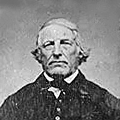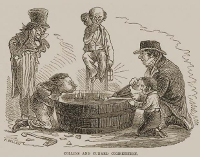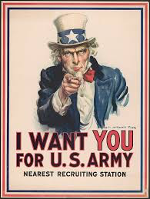The Story of Uncle Sam
The figure of Uncle Sam dates to the early 19th Century, although the current well-known image (beard and all) is much more recent. As with many American icons, the image of Uncle Sam has its origins shrouded in a bit of mystery. The most popular origin story is that of a real person, named Samuel Wilson, who lived in Troy, N.Y., in the early part of the 19th Century and supplied meat and other rations to the American troops then fighting Great Britain during the War of 1812. 
As that story goes, Samuel Wilson and his brother, Ebenezer, owned E. & S. Wilson, a meat packing facility. Samuel Wilson was liked and respected by many people, and he was often referred to as "Uncle Sam." The Wilson brothers found their products in high demand during the War of 1812 and shipped many barrels of meat to American troops. Stamped on the barrels from E. & S. Wilson was this: "E.A. –US." The "E.A." in that designation stood for Elbert Anderson, the contractor hired by the U.S. Government to find a rations distributor. And the "US," as the story goes, referred to Samuel Wilson, by way of his nickname, "Uncle Sam." In all likelihood, the "US" stood for nothing more pedestrian than "United States," but that didn't make for a story as good as the one that referred to "Uncle Sam." The idea of Uncle Sam personifying America took on a life of its own as the nation expanded its borders in the 19th Century. A likeness of Uncle Sam appeared in drawings of other well-known American figures, particularly Brother Jonathan, himself a personification of America. 
It was in 1852–on March 13, to be precise–that Uncle Sam first appeared in a cartoon. Frank Bellew of the New York Lantern included Uncle Sam, wearing a big hat and striped hats, in a cartoon titled "Raising the Wind; or, Both Sides of the Story." Also in the cartoon was John Bull, a character often used to represent Great Britain. The bearded figure wearing a stars-and-stripes suit first appeared a few years later, in a magazine cartoon drawn by Thomas Nast, the famous political cartoonist who also created the modern image of Santa Claus and who had had popularized the image of a donkey and an elephant as representations of the Democratic and Republican Parties, respectively. 
The later image of Uncle Sam as a military recruiter burst onto the scene in 1917, when James Montgomery Flagg revealed the design for the "I Want You" poster that can still be seen today, in serious and parody form. As for Samuel Wilson as Uncle Sam, the U.S. Congress has given its seal of approval for that connection, with a designation approved in 1961. Wilson lived a long life, dying in 1854 at 88. He and his wife, Betsey Mann, are buried in a Troy, N.Y., cemetery; the town bills itself as "the home of Uncle Sam." |
|
Social Studies for Kids
copyright 2002–2025
David White





